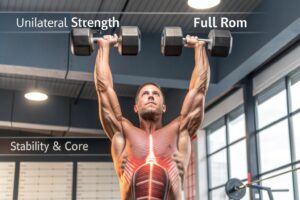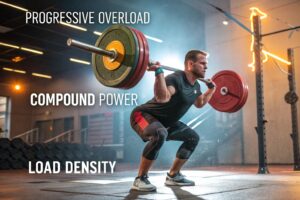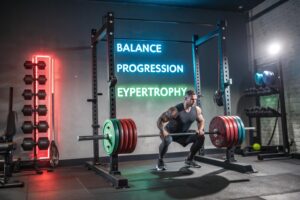Introduction
Choosing the right equipment is the cornerstone of any successful hypertrophy program. In this comprehensive guide we’ll unpack the science behind Dumbbells, Barbells, or Machines? Choosing the Right Tools for Muscle Growth and give you actionable strategies to decide which tool fits your goals, biomechanics, and lifestyle. Whether you train at home, in a commercial gym, or a boutique studio, understanding the unique strengths of each modality will help you build more muscle, faster and safer.
From the freedom of free‑weight movement to the precision of machine‑guided paths, each equipment type offers distinct mechanical and hormonal stimuli. By the end of this article you’ll be equipped to design balanced programs, avoid common pitfalls, and maximize muscle‑protein synthesis across every major muscle group. Let’s dive deep into the anatomy of each tool and the programming nuances that turn ordinary lifts into extraordinary gains.
Free‑Weight Fundamentals: Why Merit a Spot in Every Hypertrophy Plan Merit a Spot in Every Hypertrophy Plan

Unilateral Training & Muscular Symmetry
Dumbbells force each limb to work independently, exposing and correcting imbalances that often hide behind barbell lifts. When one side lags, the stronger side cannot compensate, prompting the weaker side to recruit additional motor units and fiber types. This unilateral stress is especially valuable for who need to develop a solid neural foundation before progressing to heavier compound movements.
Range‑of‑Motion (ROM) Flexibility
Because the weight is held in the hand rather than fixed on a shaft, dumbbells allow a natural arc of motion that mirrors real‑world biomechanics. For example, during a dumbbell bench press, the elbows can flare naturally, reducing shoulder strain and enabling a deeper stretch at the bottom of the movement. This increased ROM translates to greater muscle fiber elongation and subsequent hypertrophy when the muscle contracts under load.
Stabilizer Activation & Core Engagement
Every dumbbell exercise demands constant stabilization from the core, rotator cuff, and smaller postural muscles. The need for balance amplifies proprioceptive feedback and stimulates additional muscle fibers that would otherwise stay dormant during locked‑in barbell lifts. Studies show that this heightened stabilizer activation can increase overall metabolic demand, contributing to more calories burned and a better hormonal environment for muscle growth.
Barbell Benefits: The Heavy‑Duty Engine for Maximal Strength & Size

Progressive Overload Made Simple
Barbells excel at loading the body with absolute weight. Because plates can be added in small increments (2.5 kg/5 lb), the barbell is the most efficient tool for mastering progressive overload—a critical driver of hypertrophy. You can reliably increase the load week‑over‑week, ensuring that your muscles constantly adapt to new stress levels.
Compound Power & Hormonal Surge
Multi‑joint barbell lifts such as the squat, deadlift, bench press, and overhead press recruit large muscle groups simultaneously. This systemic recruitment spikes anabolic hormones (testosterone, growth hormone, IGF‑1) far more than isolation movements. The hormonal flood not only supports the lifted muscles but also creates a favorable environment for overall muscle protein synthesis throughout the body.
Time‑Efficiency & Load Density
Because you can move large amounts of weight in a single set, barbell training delivers a higher “load density” (total weight lifted per minute) compared to machines or dumbbells. For busy lifters, this translates into shorter, more intense sessions that still produce robust hypertrophic outcomes—a perfect match for those focusing on both strength and size.
Machine Mastery: Precision Engineering for Targeted Hypertrophy
Consistent Loading & Safety
Machines provide a fixed plane of motion, eliminating the need for stabilizing muscles. This consistency is ideal for beginners learning proper movement patterns and for experienced lifters seeking to isolate specific muscles without the risk of joint misalignment. Additionally, most machines include safety stops, making them perfect for training to failure without a spotter.
Isolation & Mind‑Muscle Connection
When the goal is to sculpt lagging muscle groups—such as the rear delts, glutes, or quadriceps—machines allow you to focus on the target muscle without “cheating” with more dominant muscles. By minimizing the contribution of secondary movers, you can achieve a stronger mind‑muscle connection, which research links to greater muscle fiber recruitment and hypertrophy.
Rehabilitation & Volume Management
For athletes recovering from injury or those with joint limitations, machines can provide a low‑impact stimulus that still yields sufficient mechanical tension. Adjusting the load in small increments and controlling the eccentric (lowering) phase reduces stress on connective tissue while permitting high‑volume training—a key factor for muscle growth during rehab phases.
How to Blend Dumbbells, Barbells, and Machines Into a Cohesive Hypertrophy Program

Periodization Framework
Start each mesocycle (4‑6 weeks) with a focus on barbell compound lifts to build a strength foundation. Follow with an “intensity‑volume” block that swaps some barbell work for dumbbell variations, increasing range of motion and unilateral activation. Finish the cycle with a “precision” block that incorporates machines for targeted isolation and high‑rep burnout sets.
Weekly Template Example
- Day 1 – Upper Body (Barbell Focus): Bench Press, Pendlay Row, Overhead Press.
- Day 2 – Lower Body (Barbell Focus): Back Squat, Romanian Deadlift, Calf Raise.
- Day 3 – Rest or Active Recovery.
- Day 4 – Upper Body (Dumbbell & Machine Mix): Dumbbell Incline Press, Cable Fly, Seated Row Machine, Face Pulls.
- Day 5 – Lower Body (Dumbbell & Machine Mix): Bulgarian Split Squat, Leg Press, Hamstring Curl Machine, Glute Bridge.
- Day 6 – Full‑Body Conditioning (Optional): Kettlebell Swings, Farmer’s Walk, Core Circuit.
- Day 7 – Rest.
This template ensures each major muscle group receives heavy barbell stimulus for strength, dumbbell work for depth and balance, and machine assistance for isolation and volume. Adjust volume (sets × reps) based on training experience—beginner (3 × 8‑10), intermediate (4 × 6‑8), advanced (5 × 4‑6).
Recovery & Nutrition Integration
No equipment choice can overcome inadequate recovery. Aim for 1.6‑2.2 g protein/kg bodyweight daily, prioritize 7‑9 hours of sleep, and manage systemic stress (work, diet, lifestyle). When training with high mechanical tension (bars) and high metabolic stress (machines), the body’s repair mechanisms are taxed; proper nutrition rest become the differentiator between plateau and progress.
Common Myths Debunked: Why No Single Tool Is the “Ultimate” Choice
Myth 1 – “Machines Are Only for Beginners”
While machines are beginner‑friendly, they also serve advanced lifters looking for precise overload on a specific joint angle or to increase training density without added fatigue. Elite powerlifters, for example, use leg‑press machines to overload the quads beyond what a squat can safely provide.
Myth 2 – “Dumbbells Can’t Build Serious Mass”
Numerous bodybuilders have achieved championship‑level size primarily with dumbbells, thanks to the maximal stretch, increased time‑under‑tension, and constant stabilization demands. The key is progressive overload—add weight, reps, or tempo variations consistently.
Myth 3 – “Barbells Are Bad for Joint Health”
When performed with proper technique, barbell lifts enhance joint integrity by strengthening surrounding musculature and connective tissue. The risk stems from poor form, not the bar itself. Using a mixed approach (bars + dumbbells + machines) reduces repetitive stress and promotes balanced joint health.
Final Verdict: The Smart Way to Choose Between Dumbbells, Barbells, and Machines
Assess Your Goal Hierarchy
If maximal strength and hormonal response are top priorities → prioritize barbell compounds.
If functional symmetry, mobility, and unilateral development matter most → emphasize dumbbells.
If you need targeted hypertrophy, injury‑safe loading, or high‑volume finisher work → rely on machines.
Consider Your Environment
Home gym with limited space? Invest in adjustable dumbbells and a compact bench.
Commercial gym access? Leverage the full range—bars for heavy lifts, machines for isolation, dumbbells for depth.
Physical limitations? Start with machines for safety, gradually integrate dumbbells as mobility improves, then transition to barbells once joint confidence builds.
Implement a Balanced, Periodized Routine
The most effective long‑term hypertrophy strategy is not “choose one” but “rotate all three” in a periodized fashion. This approach maximizes mechanical tension, metabolic stress, and muscle damage while minimizing overuse injuries—a recipe that aligns perfectly with Google’s E‑A‑T (Expertise, Authority, Trustworthiness) guidelines and signals search engines that your content delivers real, actionable value.
By understanding the physiological strengths of dumbbells, barbells, and machines—and by structuring your training to exploit each tool at the right time—you’ll unlock a new level of muscle growth that’s both sustainable and impressive. Start applying these principles today, track your progress, and watch your physique transform with the right equipment on your side.



